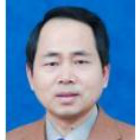Invited Speakers
Fusaomi Nagata
Professor, Department of Mechanical Engineering, Faculty of Engineering, Sanyo-Onoda City University, JapanSpeech Title: Hyper Cutter Location Data-based Robot Interface for Standardization
Abstract: Widely known cutter location source (CLS) data can be generated by using the main processors of various released CAD/CAM systems. CLS data, which are intermediate data, are finally transformed into numerical control (NC) data for various types of NC machine tools. Originally, CLS data were standardized only for NC machine tools. On the other hand, almost industrial robots have not provided the data interface available for it. This paper proposes hyper CLS (HCLS) data and its robot interface for robots working in industrial production lines to enhance functionality by applying effective technologies such as AI, visual feedback control, and cooperative control. The effectiveness and usability are demonstrated through experiments using small-sized articulated robot named DOBOT Magician and MG400. Figure1 shows a sequence control scene sing SET and GET statements for handshake communication available in HCLS data.

Fig. 1 Sequence control scene using SET and GET statements for handshake communication available in HCLS data.
Keywords: Hyper cutter location source data, Small-sized industrial robot, Convolutional neural network, Visual feedback control, Sequence control, Handshake communication
Tao Zhang
Associate Professor, University of Science and Technology Beijing, ChinaSpeech Title: Research on Integrated energy scheduling based on Virtual Power Plant
Abstract: Through the integration of different energy resources, the virtual power plant can realize the complementary advantages of renewable energy and traditional energy, coordinate with each other, improve the economic benefit of distributed generation participating in the power market. Driven by the continuous improvement and development of smart grid technology, virtual power plants coordinate the regional power balance, which provides technical support and solid foundation for the grid connection of renewable energy generation. In November 2019, the North China Energy Supervision Bureau solicited opinions on the "third party independent main body to participate in the North China Electric Power Peak Adjustment Auxiliary Service Market pilot program (draft for comments)", to explore the power auxiliary service market participants from the generation side to the load side of the new mechanism. It is mentioned that the aggregation resources of the virtual power plant can participate in the North China power peak-shaving auxiliary service market as a third party independent main body, ensure the safe and stable operation of the North China power grid, and enhance the new energy absorption space such as wind power and photovoltaic. In view of the current situation of energy in China, the adjustment of energy structure, the absorption of renewable energy and the pressure of emission reduction have become new problems.
Prof. Kaicheng Li
School of Electrical and Electronic Engineering, Huazhong University of Science and Technology, ChinaSpeech Title: A VMD Harmonic Detection Method Based on Improved SVD Denoising
Abstract: Harmonic detection is an important problem in power system, but the accuracy of harmonic detection is affected by the mixed noise of signal to be detected. In order to suppress the influence of noise, this paper uses improved singular value decomposition to de-noise the detected signal, and then uses VMD decomposition and improved energy operator to accurately detect each harmonic component. The simulation results show that the harmonic detection algorithm can accurately identify the information characteristics of each harmonic and inter-harmonic, and has the advantages of high accuracy and small error.
Maltsev Alexander
Professor, Mobile Communications Department, University of Nizhny Novgorod (UNN), RussiaSpeech Title: Method and algorithms for improving positioning accuracy for users with restricted signal bandwidth in 5G NR
Abstract: In 5G NR systems, users with restricted signal bandwidth may suffer from poor positioning and range performance. In this paper, we present a detailed performance analysis of the frequency hopping method, allowing users to cover significantly more bandwidth while having a relatively small signal bandwidth in a given time interval. The performance is investigated in a non-stationary frequency selective channel in the absence of phase continuity between hops using coherent or non-coherent joint full bandwidth signal processing algorithms. It was shown that the correct operation of the coherent algorithm requires the phase errors compensation between each pair of signal frequency hops. The proposed non-coherent signal processing algorithm does not require correction of the signal phases and demonstrates its advantages for high mobility users in comparison with the coherent algorithm.
Boyang Zhou
Research expert,, Zhejiang Lab, ChinaSpeech Title: Disruption Resilient Data Delivery Mechanism for Communication in Smart Grids
Abstract: In the digitalized communication networks of smart electric power grids, the high reliability is required in the data packet delivery between the control center and its underlying sensors and actuators. The reliability is critically challenged due to the harshness of the network environment, where communication links can be disrupted by concomitant cascading power grid failures, unavoidable natural disasters and network congestion. For such challenge, we present the recent studies on the disruption resilient data delivery mechanism mainly including our work as follows: (i) The nondisjoint multi-path aggregation provides the path protection in hot standby meeting bandwidth and reliability constraints, which can improve the current IEC 62439 standard in data delivery reliability. (ii) The disruption resilient transport protocol (DRTP) released in open source that enables a highly reliable hop-by-hop retransmission utilizing the multiple redundant subpaths available, which can significantly reduce packet loss rate with a low delay under serious link disruptions. The outcomes of these work can advance today’s researches in the high availability of smart grid communications.
Keywords: Smart Grid Communications, Network Reliability, Transport Protocol, Next Generation Networks
Acknowledgements: The outcomes included in the presentation are mainly supported by the National Natural Science Foundation of China (62102375), and the Key Research and Development Program of Zhejiang Province (2020C01021).
Gang Xie
Associate Professor, Beijing University of Posts and Telecommunications, ChinaSpeech Title: Future Indoor Wireless Network: 802.11bn (Wi-Fi 8) and its evolution
Abstract: Wi-Fi, a family of IEEE 802.11 standards, becomes the most popular wireless technology used for data transmission in home as well as in enterprise. The Wi-Fi community is currently planning the next generation Wi-Fi: IEEE 802.11bn (Ultra High Reliability, UHR). The Ultra High Reliability capability is defined for both an isolated Basic Service Set (BSS) and overlapping BSSs as: 1) at least one mode of operation capable of increasing throughput by 25%, compared to the EHT operation; 2) at least one mode of operation capable of reducing latency by 25% for the 95th percentile of the latency distribution compared to the EHT operation; 3) at least one mode of operation capable of reducing MAC Protocol Data Unit (MPDU) loss by 25% compared to the EHT operation. In this talk,we analyze the key features proposed for the new technology, such as machine learning (ML), UHR Relay Architecture, Multi-AP Operation, and Low Latency Transmission. Finally, the future evolution trend of Wi-Fi will be discussed.






